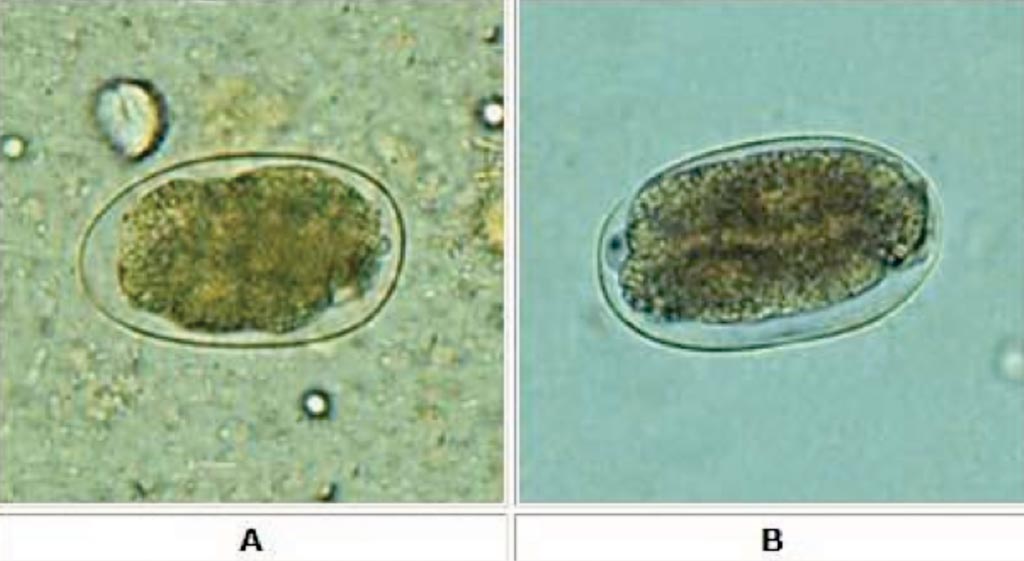Diagnostic Sensitivity of Kato-Katz Technique Estimated
By LabMedica International staff writers
Posted on 17 Oct 2017
Soil-transmitted helminthiasis (STH) and schistosomiasis are two of the most prevalent neglected tropical diseases with more than one billion and over 250 million people affected worldwide, respectively.Posted on 17 Oct 2017
The Kato-Katz technique is the most widely used diagnostic method in epidemiologic surveys and drug efficacy trials pertaining to intestinal schistosomiasis and soil-transmitted helminthiasis. However, the sensitivity of the technique is low, particularly for the detection of light-intensity helminth infections.

Image: Hookworm eggs examined microscopically on wet mount using the Kato-Katz technique (eggs of Ancylostoma duodenale and Necator americanus cannot be distinguished morphologically. The embryo in (B) has begun cellular division and is at an early (gastrula) developmental stage (Photo courtesy of Vishnu Vardhan Serla / Maheep Sangha).
Scientists at the Swiss Tropical and Public Health Institute (Basel, Switzerland) and their African colleagues tested their model performing a secondary analysis based on the Kato-Katz assay, hookworm prevalence varied from 11.4% to 59.0%, and mean or infected population based infection intensity from 280 eggs per gram of stool (EPG) to 396 EPG. For Schistosoma mansoni, prevalence varied from 35.6% to 76.3%, and infection intensity from 152 EPG to 307 EPG. Between two and four stool samples were collected and analyzed on consecutive days of a total of 1,423 participants.
The a model which estimates the sensitivity of the Kato-Katz technique in Schistosoma mansoni and hookworm, as a function of infection intensity for repeated stool sampling and provide estimates of the age-dependent ‘true’ prevalence. The team found that the sensitivity for S. mansoni diagnosis is dominated by missed light infections, which have a low probability to be diagnosed correctly even through repeated sampling. The overall sensitivity strongly depends on the mean infection intensity. In particular at an intensity of 100 eggs per gram of stool (EPG), they estimated a sensitivity of 50% and 80% for one and two samples, respectively.
The team reported that at an infection intensity of 300 EPG, they estimated a sensitivity of 62% for one sample and 90% for two samples. The sensitivity for hookworm diagnosis is dominated by day-to-day variation with typical values for one, two, three, and four samples equal to 50%, 75%, 85%, and 95%, respectively, while it is only weakly dependent on the mean infection intensity in the population. The sensitivity was strongly associated with S. mansoni infection intensity. In particular, for very light infections ( less than five EPG), it was below 50% even after three samples.
The authors recommend collecting at least two stool samples over subsequent days combined with the given sensitivity values to estimate ‘true’ prevalence. For S. mansoni infection the sensitivity is largely driven by light infections that are hard to detect by a single Kato-Katz thick smear. They also recommend collecting two samples due to almost perfect sensitivity for moderate and heavy infections and low benefit of additional samples for light infections. They predict that improving the sensitivity for S. mansoni can be achieved more cost effectively by increasing the number of Kato-Katz thick smears from the same stool sample instead of increasing the number of samples taken. The study was published on October 4, 2017, in the journal Public Library of Science Neglected Tropical Diseases.
Related Links:
Swiss Tropical and Public Health Institute














